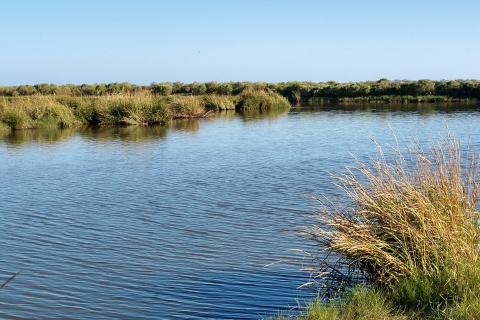The Louisiana Trustee Implementation Group, the agencies charged with restoring Louisiana’s natural resources after the Deepwater Horizon oil spill, has released the Mid-Barataria Sediment Diversion Final Restoration Plan (PDF, 1,123 pages). The plan evaluates using a large-scale sediment diversion to reconnect the Mississippi River to Louisiana's Barataria Basin estuary to restore wetlands and contribute to the broader restoration of its ecosystem. If it is ultimately permitted and funded, this first-of-its-kind project, estimated to cost more than $2 billion, represents one of the largest and most innovative coastal habitat restoration efforts ever undertaken.
The Final Restoration Plan provides an in-depth analysis of the benefits and impacts of a Mid-Barataria Sediment Diversion project, and selects a preferred alternative for implementation. The project would re-establish historic delta processes by allowing for the controlled release of water, sediment, and nutrients from the Mississippi River into the Barataria Basin estuary, supporting ecosystem-scale restoration of the estuary.
Over 50 years, the sediment carried by the diversion is projected to restore over 13,000 acres of wetland habitat—which is 20 square miles, or the size of Breton National Wildlife Refuge. These restored wetlands would contribute to protecting communities and infrastructure, reducing impacts from storms, supporting healthier Gulf fisheries, and benefiting many species important to the region’s economy and environment.
“The Deepwater Horizon oil spill had a profound impact on the northern Gulf of Mexico,” said Janet Coit, Assistant Administrator for NOAA Fisheries. “I am proud of the strong collaboration with our partners over many years that resulted in a plan to sustainably rebuild these vital coastal wetlands.”
Restoration Plan Evaluation and Timeline
In this Final Restoration Plan, the Louisiana Trustee Implementation Group evaluated six sediment diversion alternatives. In selecting the preferred alternative, the Trustees considered the benefits and impacts of each alternative, and reviewed extensive public input received on the Draft Restoration Plan, published in March 2021.
Throughout the plan’s development, the Trustees also participated in the U.S. Army Corps of Engineers’ environmental impact evaluation of the proposed sediment diversion project. Concurrent with this release of the Trustees’ Final Restoration Plan, the Army Corps has released the Final Environmental Impact Statement (FEIS), available at the Army Corps’ website. The Final Restoration Plan and FEIS will be considered by the Trustees to inform a final decision on implementing this project. That decision is anticipated to be made later this year.
If implemented, project costs are anticipated to exceed $2 billion. Costs include funds for monitoring and evaluation, and a suite of stewardship and mitigation measures to offset adverse impacts where possible.
Louisiana Coastal Protection and Restoration Authority (CPRA) and NOAA are the lead Trustees for this Final Restoration Plan, which was prepared jointly with the other Louisiana Restoration Area Trustees: the U.S. Department of the Interior, the U.S. Environmental Protection Agency, and the U.S. Department of Agriculture.
“The Mid-Barataria Sediment Diversion has the potential to build and maintain more land than any other project in Louisiana’s Coastal Master Plan. These wetlands are critical to the protection of the communities, fisheries, and economies in Louisiana—and all that our coast supports across the country,” said Chip Kline, Chairman of the Louisiana Coastal Protection and Restoration Authority Board. “The project is a cornerstone of our state’s coastal program and represents the best in innovative science and collaboration across agencies to protect and restore the ecosystem.”
Historic Context
Louisiana’s wetlands act as critical foraging, nursery, and nesting grounds for hundreds of species of fish and other wildlife. The Deepwater Horizon oil spill was the largest in U.S. history, impacting the entire northern Gulf of Mexico ecosystem. The wetlands in the Barataria Basin estuary were the most heavily impacted.
The oil spill and response accelerated an ongoing trend of coastal land loss, especially in the state’s Barataria Basin estuary. The species, fisheries, and communities that rely on estuarine habitats face serious challenges due to the continued loss of wetlands, increasing estuarine salinities, as well as sea level rise, and land subsidence.
Since the spill, the Louisiana Trustee Implementation Group has approved 78 restoration projects. Several are currently underway in the Barataria Basin estuary, including the Upper Barataria Marsh Creation and Spanish Pass projects.
More Information and Plan Documents
- Final Phase II Restoration Plan #3.2: Mid-Barataria Sediment Diversion Restoration Plan (PDF, 1,123 pages)
- Executive Summary (English, PDF, 4 pages; Spanish, PDF, 5 pages; Vietnamese, PDF, 4 pages)
- Mid-Barataria Sediment Diversion Fact Sheet (PDF, 3 pages)
- U.S. Army Corps of Engineers Final Mid-Barataria Sediment Diversion Project Environmental Impact Statement
Get future updates delivered directly to your inbox. Subscribe today for Gulf Spill Restoration news and updates.


